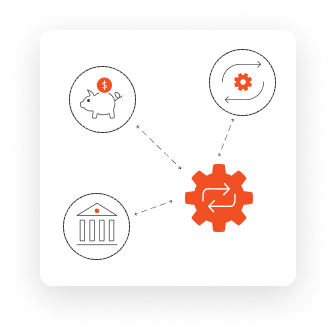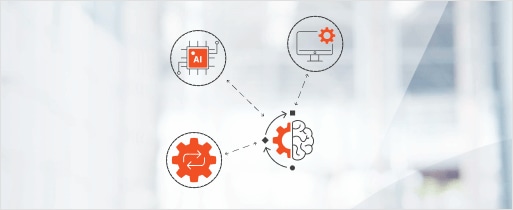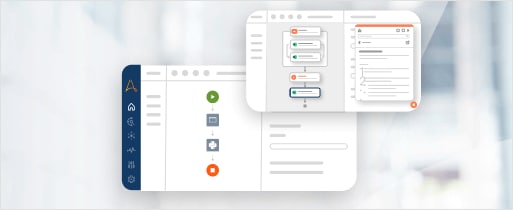What is banking automation and how do banks use it?
When banks, credit unions, and other financial institutions use automation to enhance core business processes, it's referred to as banking automation.

Banking and financial business processes involve an overabundance of repetitive tasks, making them ideal for banking automation technology. And the banking industry has absolutely been a leader in embracing low/no-code automation technologies such as robotic process automation (RPA) and intelligent document processing (IDP) to automate repetitive processes like data entry and document handling.
Now, with advances in AI and automation technology, banking automation extends to complex processes that involve analyzing unstructured data, detecting patterns, and making real-time decisions, reshaping traditional banking processes.
In particular, the arrival of agentic process automation (APA) empowers banks to automate dynamic workflows where both adaptability and accuracy are vital, like fraud detection, risk management, and customer service. With APA, banks can unify customer data to deliver cohesive, value-driven, and personalized services, boosting competitiveness.
Embracing agentic AI for banking automation isn't just a technological upgrade; it's a paradigm shift in how banks operate. With agentic automation tools and solutions, banks and credit unions can achieve greater operational efficiency, ensure regulatory compliance, and meet the growing demand for self-service and digital transformation.
Key article takeaways:
- Banking automation, especially through agentic process automation (APA), is reshaping operations and improving customer experiences. With AI-driven automation, banks can adapt to change, manage risks more effectively, and deliver personalized services.
- Agentic AI is driving future-ready banking, enabling automation to expand to areas such as sustainability reporting and compliance with environmental, social, and governance (ESG) standards.
- Building on core automation technologies, APA delivers significant cost savings and operational scalability when applied through a unified, cloud-native platform upholding strict security and compliance standards.
Tour the secure Agentic Process Automation System
Advantages of automation for banks.
Products and services across banking and financial institutions can benefit from automation, whether in delivering drastically shortened response times or increasing the value of each work hour through higher productivity.
By leveraging technologies like RPA and agentic AI, banks can address inefficiencies, improve accuracy, and scale services to meet growing demands.
Increased efficiency and lower operational costs
Automation eliminates time-consuming manual tasks such as data entry and transaction reconciliation, processing thousands of transactions in a fraction of the time it would take humans. This efficiency accelerates workflows and significantly reduces operational costs.
Banking automation has become one of the most accessible and affordable ways to streamline time-consuming tasks and integrate with downstream IT systems to maximize operational efficiency. Additionally, banking automation provides financial institutions with more control and a more thorough, comprehensive analysis of their data to identify new opportunities for efficiency and cost savings.
For example, automating back-office processes like accounts payable and receivable can cut processing times by up to 80%, leading to substantial savings. This level of banking innovation allows financial institutions to allocate resources more effectively.
Improved accuracy and reduced human error
Manual processes are prone to errors, especially in repetitive tasks like data entry or compliance checks. Automation tools ensure consistent accuracy by following predefined rules and algorithms, minimizing the risk of human error.
AI-powered systems can cross-verify customer data during onboarding, ensuring compliance with Know Your Customer (KYC) regulations while reducing inaccuracies. This precision makes a critical difference in areas like fraud detection, where even minor errors can have significant financial and reputational consequences.
Better, faster customer experiences
Customers want to get more done in less time from interactions with their financial institutions. Automation enables banks to deliver faster, more personalized services that not only improve customer satisfaction but also foster loyalty in an increasingly competitive financial technology landscape.
For instance, chatbots and virtual assistants, powered by AI agents and NLP, provide real-time support, answering customer questions and resolving issues right away. And automated loan origination systems streamline application processes, allowing customers to receive approvals in minutes rather than days.
Stronger compliance and risk management
Financial institutions face strict regulatory requirements that necessitate accurate data tracking and reporting. Automation helps banks maintain compliance by generating real-time reports and audit trails, monitoring transactions for suspicious activities, and ensuring that necessary documentation is up to date.
This proactive approach reduces the burden on compliance teams while enhancing accuracy and transparency—minimizing the risk of non-compliance penalties and supporting the institution's reputation.
Scalability and adaptability
As banks grow and evolve, so do their operational complexities. Automation provides the scalability needed to handle increased workloads and transaction volumes without proportional increases in resources. Automated systems can easily integrate with new technologies and processes, enabling banks to innovate rapidly.
Low-code automation platforms allow financial institutions to quickly adapt workflows to meet changing business needs. Whether it's expanding customer onboarding capabilities or integrating new fintech apps, automation is integral to scaling banking operations seamlessly.
For example, banks and the financial services industry can now leverage large databases with varying structures, data models, and sources. As a result, they're better able to identify investment opportunities, spot underperforming investments earlier, and match investments to specific clients much more quickly than ever before.
What banking processes are candidates for automation?
Banking automation is no longer limited to predictable, structured tasks. Flexible, AI-powered automation combines automation technologies like RPA with AI agents to transform complex, multi-system processes across banking operations and use cases.
Customer service automation
Customer service is one of the most visible areas where automation makes a significant difference. Chatbots and virtual assistants powered by AI agents and NLP can handle routine inquiries like account balances and transaction histories in real time.
Agentic automation is also emerging as a powerful assistive tool to augment human customer service agents. Operating in tandem with service agents to execute data updates and extract information across systems, AI agents also support calls with expert-level guidance. These tools reduce the workload on human agents while providing customers with faster, 24/7 support.
Fraud detection and prevention
Fraud detection is a critical area where automation technologies excel. AI-driven algorithms can analyze vast amounts of transaction data in real time, identifying unusual patterns that may indicate fraudulent activity.
For instance, if a customer's credit card is suddenly used in a foreign country while their mobile device remains at home, the agentic automation system can flag the transaction for review or automatically block it, contact the customer to notify them, and initiate a card replacement process. This proactive approach protects customers and reduces financial losses for the bank.
Loan processing and origination
The loan application process is often time-consuming and paper-intensive. Simple automation can handle tasks like data entry, document verification, and credit checks, significantly reducing processing times.
A document automation system can extract information from a borrower's documents, cross-check it with databases, and flag discrepancies for review.
Agentic automation systems use AI agents to streamline the loan application process by integrating data from multiple sources, such as credit bureaus and financial histories. These agents can quickly assess creditworthiness and make decisions on loan approvals within minutes.
Applying agentic automation to loan origination accelerates approvals and enhances accuracy, reducing the risk of errors that could lead to compliance issues.
Accounts payable and receivable
Automation tools can simplify manual tasks like invoice processing and payment reconciliation workflows by extracting data from invoices, matching it with purchase orders, and updating financial systems automatically, delivering efficiencies that help banks maintain better relationships with vendors and clients while optimizing cash flow.
RPA alone can process hundreds of standard invoices in minutes, ensuring timely payments and reducing the risk of late fees. Adding AI to these workflows expands the flexibility and reach of the automation to process invoices in any format, match them with purchase orders, and facilitate timely payments while ensuring accuracy through validation checks.
Compliance and KYC verification
Regulatory compliance is a top priority for financial institutions but often involves labor-intensive processes like KYC verification. Automation can streamline these tasks by using AI and ML to analyze customer data, verify identities, and flag potential risks.
An intelligent automation system can cross-reference a new customer's information with government databases and watchlists, ensuring compliance with anti-money laundering (AML) regulations.
Compliance automation can leverage AI agents to monitor regulatory changes and automatically generate compliance reports. These systems can analyze large volumes of data to ensure that banks adhere to regulatory requirements without extensive manual oversight.
Document processing
Banks handle vast amounts of documentation daily. Automation technologies like optical character recognition (OCR) combined with AI can extract and process data from documents quickly and accurately.
For example, an automated system can scan a mortgage application, extract relevant details, and input them into the bank's system without human intervention, saving time and reducing errors from manual data entry.
Risk management
Effective risk management requires analyzing large datasets to identify potential threats and opportunities. Agentic automation tools equipped with advanced analytics and ML can process this data more efficiently than traditional methods.
For example, an AI-driven system can evaluate market trends, customer creditworthiness, and operational risks, providing actionable insights to decision-makers. Automating risk assessment allows banks to make informed decisions and respond to challenges quickly.
How automation works in banking.
Banking automation involves applying the right set of technologies—including RPA, AI, ML, NLP, and API integrations—to each task, workflow, or banking process. The goal is to automate entire workflows, connecting various tasks and systems from process initiation to completion.
In banking, this involves creating seamless connections between front-office functions (such as customer service and sales) and back-office operations (such as compliance and risk management). For example, when a customer applies for a loan, automation can streamline the entire process—from application submission and credit scoring to approval and disbursement—by integrating RPA, AI, and APIs.
With the arrival of agentic process automation (APA), banks and financial institutions are harnessing agentic AI systems to dynamically execute workflows and orchestrate tasks across departments and applications.
Technologies enabling banking automation
Robotic process automation (RPA)
RPA serves as a reliable task execution foundation for banking automation, handling rule-based, repetitive tasks with precision and speed. Software “bots” mimic human actions like data entry and transaction reconciliation without requiring human intervention.
Artificial intelligence (AI) and machine learning (ML)
AI and ML elevate automation by enabling systems to learn, adapt, and make decisions based on data patterns. Unlike RPA, which follows predefined rules, AI-driven automation can analyze unstructured data, predict outcomes, and optimize processes.
For example, in fraud detection, AI algorithms can monitor transaction patterns in real time, flagging anomalies that may indicate fraudulent activity. ML models are invaluable for continuously refining accuracy by learning from historical data, making them indispensable for areas like risk management and compliance.
Natural language processing (NLP)
NLP enables systems to understand and respond to human language. This technology is central to generative AI chatbots and virtual assistants that handle customer inquiries, provide account information, and guide users through complex processes.
API integrations
API integrations connect disparate banking systems, creating seamless workflows and enabling end-to-end process automation. This connectivity eliminates silos, accelerates decision-making, and ensures data consistency across platforms. For example, APIs can link loan origination systems with credit scoring platforms, automating the loan application process from submission to approval.
Intelligent automation and decision-making
Intelligent automation integrates RPA, AI, and ML to enable systems to make informed decisions with minimal human intervention, enabling the automation of more complex, end-to-end processes.
For example, in loan processing, intelligent automation can assess creditworthiness, verify documents, and approve applications in real time, delivering faster outcomes for both banks and customers.
Agentic process automation and AI agents
Agentic process automation (APA) is redefining the boundaries of banking automation. APA harnesses AI agents to autonomously manage tasks, analyze data, adjust processes, and handle exceptions without continuous human oversight.
AI agents can interpret objectives and manage complex workflows, making decisions in response to dynamic conditions and determining the best course of action to achieve defined goals. Integrating seamlessly with existing systems, APA allows for greater flexibility and adaptability in workflows, as AI agents can assess situations in real time and adjust actions accordingly.
Goal-oriented operation
Unlike traditional automation tools, like RPA, which follow predefined steps and rules, agentic automation is goal-oriented.
In the context of banking, this means that AI agents interpret an objective, like reducing loan approval times, and autonomously determine the best actions to achieve the goal.
Dynamic decision-making
In contrast to executing tasks in a fixed sequence, agentic AI can assess situations and data to make decisions on the fly.
For example, when assessing a loan application, an AI agent can analyze factors such as credit history, income verification, and market trends to determine the most favorable decision path, all while striving to meet the overarching goal of optimizing risk management and customer satisfaction.
Adaptability to change
Agentic automation excels in environments where conditions may change rapidly. While traditional automations require manual updates to process flows when new scenarios arise, agentic AI can learn from new data and adapt its strategies in real time.
Adaptability is particularly valuable in banking, where market conditions, regulatory requirements, and customer needs can shift quickly.
Collaboration across systems
APA seamlessly connects systems and departments within a bank. Leveraging APIs and existing software solutions, AI agents orchestrate tasks across platforms—such as customer service, compliance, and risk management—based on the goals they are designed to achieve. This dynamic interconnectedness drives efficient flows of information flows, supporting overall operational effectiveness.
Challenges and risks of banking automation.
Achieving the benefits of banking automation is not always a straightforward journey; financial institutions must navigate hurdles to ensure successful adoption and long-term sustainability. But understanding the risks and common setbacks enables approaching automation strategically and can smooth the journey to maximizing the value of automation technologies.
One major barrier to adopting banking automation is high upfront investment. Deploying automation tools like RPA or AI-driven solutions requires substantial financial resources. Costs include purchasing software, integrating it with existing systems, and training employees.
For smaller institutions, the size of implementation expenses can lead to delays in fully adopting automation across operations, potentially hampering the ability to compete with larger market players.
Legacy systems, still common in banking, can pose another challenge.
While UI-based and adaptive automation solutions like APA can operate across any system, many automation solutions are not designed for integration simplicity. That means financial institutions can face compatibility issues, requiring custom development or middleware to bridge the gaps between outdated infrastructure. This process can lead to delays, increased costs, and operational disruptions.
Automation systems handle sensitive customer data, like personal identification information and financial records, making them attractive targets for hackers. Ensuring that this data is protected and used responsibly is paramount. Banks must implement strict data governance policies and comply with privacy regulations to maintain customer trust. A breach in these systems could lead to significant financial losses, reputational damage, and regulatory penalties.
Ensuring robust cybersecurity measures like encryption, multi-factor authentication, and continuous monitoring is critical to safeguarding automated banking workflows.
Compliance is the other side of the coin. The financial services industry operates under strict regulatory frameworks, and automation must align with these requirements. Implementing automation solutions that comply with KYC standards, AML regulations, and other mandates can be challenging. Any misstep in compliance could result in fines or legal repercussions.
Financial institutions must work closely with automation providers to ensure that their solutions meet regulatory standards and can adapt to evolving compliance requirements.
And influencing all of these challenges is the question of organizational adoption. Employees may feel apprehensive about new technologies, fearing job displacement or the need to acquire new skills. This resistance can be particularly pronounced among mid-level managers and frontline staff who may be uncertain about how automation will impact their roles and responsibilities. Moreover, the complexity of existing workflows and legacy systems can create significant barriers to implementation, as employees may be accustomed to traditional processes and hesitant to adopt new ones.
At the same time, senior leadership may struggle with aligning automation initiatives with strategic goals, leading to a lack of clear direction and support for change. Without strong advocacy from leadership, it becomes difficult to foster a culture of innovation and acceptance among employees.
Ultimately, employees at all levels require comprehensive training, upskilling, and ongoing support.
Last but not least, automated systems require robust governance and oversight. While automation reduces human error and enhances efficiency, over-reliance on these technologies can introduce risks. Automated systems may fail to adapt to unexpected scenarios that require human judgment.
There is also the risk of algorithmic bias. AI systems used in automation may inadvertently perpetuate biases present in their training data. This can lead to unfair outcomes in areas like loan approvals or fraud detection. Financial institutions need to regularly audit and adjust algorithms to ensure fairness and transparency.
Maintaining a balance between automation and human intervention is essential to ensure accuracy, adaptability, and responsibility in complex processes.
Platform solutions for banking automation.
Integrated automation solutions unify automation tools and technologies, eliminating the complexities of managing multiple disparate systems, which can lead to data silos and inefficiencies.
Using an integrated platform rather than individual tools simplifies implementation, deployment, maintenance, and support, reducing the total cost of ownership and making it easier to take advantage of updates and new features.
Agentic process automation (APA) systems stand out as particularly valuable for banking automation. They complement integrated platforms by providing a higher level of sophistication in process management. With APA, banks can automate intricate workflows that require dynamic decision-making and contextual understanding.
By adopting comprehensive automation solutions, banks can streamline operations, enhance collaboration across departments, and ensure that all automation efforts are coordinated and aligned with organizational goals.
Key features of integrated automation platforms
-
End-to-end process automation capabilities: Comprehensive automation platforms enable banks to automate entire workflows, from customer onboarding to loan processing and compliance checks. This end-to-end capability ensures that processes are executed efficiently and consistently, reducing manual intervention and the risk of errors.
For example, a platform might automate the entire loan application process—from document collection and verification to credit risk assessment and final approval—ensuring faster turnaround times and improved accuracy. - Built-in AI and ML: Advanced automation platforms come equipped with built-in artificial intelligence (AI) and machine learning (ML) functionalities. These features allow banks to leverage data analytics for predictive modeling, fraud detection, and customer segmentation, leading to more informed decision-making and improved service delivery.
- AI agents: The integration of AI agents within automation platforms enables intelligent decision-making and real-time responses in dynamic environments, such as stock market movements or customer interactions. AI agents can autonomously manage complex tasks, analyze data, provide insights, and take action—further accelerating banking processes and improving customer interactions.
- Low-code/no-code development: Many automation platforms offer low-code or no-code development environments, enabling business users to create and modify workflows without extensive programming knowledge. This democratizes automation, allowing teams across the organization to contribute to process improvements and adapt to changing business needs quickly.
- Pre-built templates and connectors for banking processes: Automation platforms often include pre-built templates and connectors specifically designed for common banking systems and processes, such as account management, transaction processing, and compliance reporting. These resources accelerate implementation and reduce the time required to deploy automation solutions.
- Robust security and compliance features: Given the sensitive nature of financial data, automation platforms prioritize security and compliance. They provide robust security features, including data encryption, access controls, audit trails, and compliance with regulatory standards such as GDPR and PCI DSS, ensuring that banks can meet regulatory requirements while protecting customer information.
The philosophy of hyperautomation underpins many of these solutions, emphasizing integrating multiple automation technologies to create a cohesive, intelligent system. Hyperautomation goes beyond automating individual tasks; it focuses on automating entire business processes, leveraging AI and ML to continuously improve and adapt. For banks, this means achieving operational efficiency and unlocking new opportunities for innovation and growth.
Future trends in banking automation.
The financial industry is at a pivotal moment, where the integration of advanced technologies will redefine how banks operate, engage with customers, and manage compliance and sustainability efforts.
The shift toward AI-driven automation is accelerating across all industries, particularly in the banking sector. Agentic AI and agentic process automation (APA) represent a significant leap forward in how organizations can manage operations.
Financial institutions are increasingly recognizing the value of agentic AI; this level of intelligence allows banks to automate dynamic workflows that require contextual understanding and decision-making.
APA builds on the benefits of intelligent automation—enhanced efficiency, reduced operational costs, and improved customer experiences—while also adding the ability to navigate complexities, manage risks, and anticipate customer needs.
Embracing APA, with the ability to deploy intelligent agents across functions—from customer service to risk management—will enable banks to respond faster to evolving customer demands and regulatory requirements. Organizations that harness the power of agentic AI will be better equipped to innovate and thrive in an increasingly complex financial services landscape.
And as banking automation matures, financial institutions are increasingly extending automation efforts beyond core operations. They are now exploring its potential in areas like sustainability reporting and compliance with environmental, social, and governance (ESG) standards.
The growing emphasis on corporate responsibility and sustainable practices is prompting banks to adopt automated solutions that facilitate accurate reporting and adherence to regulatory standards. Automating sustainability efforts not only helps organizations meet ESG commitments but also positions them as responsible corporate citizens in the eyes of customers and stakeholders.
Unlocking the potential of banking automation with Automation Anywhere.
Banks are undergoing a remarkable transformation driven by automation and, most recently, agentic automation. As financial institutions embrace AI-powered automation and agentic technologies, they are finding new ways to streamline operations, mitigate risks, and deliver personalized services.
Leading the evolution of agentic process automation technology, Automaton Anywhere has a proven track record of enabling banks like KeyBank and Bancolombia to seamlessly automate processes across operations, delivering millions of dollars in savings—and 1300% ROI.
Automation Anywhere’s agentic process automation system powers end-to-end automation of complex banking processes while maintaining strict security and compliance standards. Integrating the full range of tools, from RPA to AI agents, within a unified, cloud-native platform designed for agility and growth, Automation Anywhere enables banks to scale automation efforts while maintaining strict security and compliance standards.
Unlock new levels of scalability, agility, and cost savings and pave the way for a future defined by intelligent, customer-centric banking. Discover what agentic automation can do for you—request a demo today.











